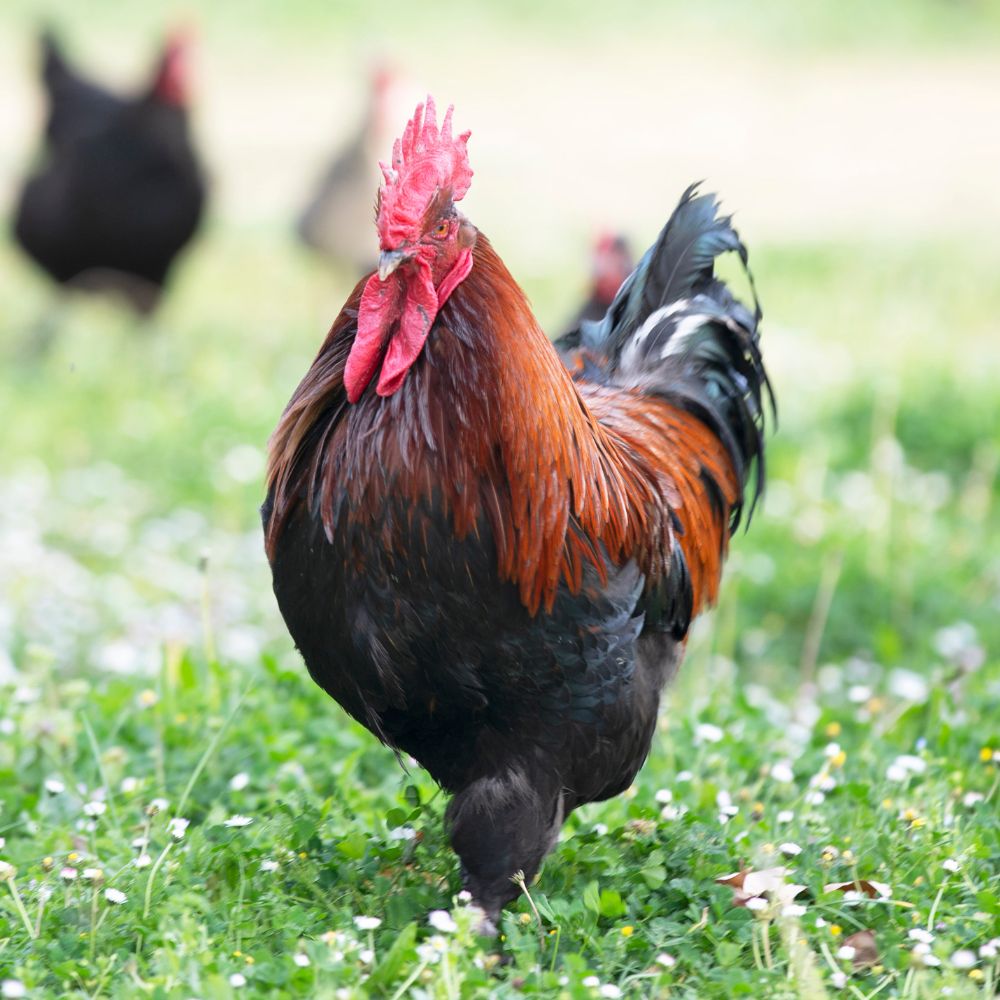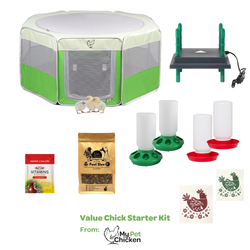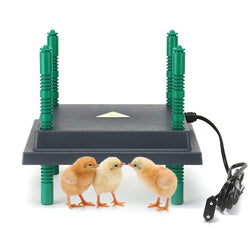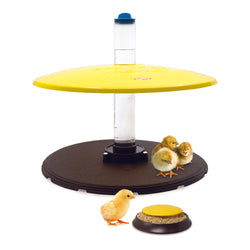How can I tell if my juvenile bird is a rooster?
Back to blog
Comb size and redness can be one indicator, but is not usually reliable. In fact, it's one of the worst indicators you can use, as comb size varies by breed and even individual. For instance, one of my hens has a larger comb than any of her sisters of the same breed, and a larger comb than any of my roosters, too.
When sexing most juveniles, the best, most fail-safe method is to look at the saddle feathers in front of the tail when the bird is about 3 months old. By that age, cockerels will have long and pointy saddle feathers, while a hen's will be rounded.
Take a look at this rooster's saddle feathers. See how long and skinny and pointy they are?

Here's a close up of the feathers in a rooster's saddle. They are golden in this photo:

Those saddle feathers start coming in at about 3 months. (The shiny, black, curving feathers are the sickle feathers that appear a bit later and can get quite long in some breeds.) Hens just don't have those skinny saddle feathers in front of their tails--their feathers are more rounded--and they don't have long, skinny sickle feathers, either.

The hackle feathers, or the feathers around the neck, are different in hens and roosters, too. Again, rooster hackles are longer and pointier.

But don't be fooled. Hen hackles can look a little pointy, too. However they're not as thin or as long as rooster feathers. Take a closeup look at hen hackles:
Now here's a closeup of rooster hackles to compare:

Notice that you can really tell more of a difference in the slender shape of the hackles further up the neck toward the head, rather than where they meet the body feathers.
How else can you tell? Crowing is a fairly good indicator, but isn't fail-safe, either, because some hens do crow. Plus, generally speaking, you will be able to tell by feathers much earlier since roosters don't usually begin to crow until they are 4 or 5 months old. However, we have had roosters wait until a little later, and begin a little sooner, too. To reiterate, the BEST way to tell for sure is by looking at physical characteristics that cannot be mistaken, so check feather shape when your birds are about 3 months old, as other indications are not reliable.
The shapes of these hackle and saddle feathers will indicate for sure whether you have a cockerel or a pullet... in every breed but Silkies and Sebrights.For sebrights, the cockerels are "hen feathered," meaning the males have the same shape feathers as females. For sebrights, comb size and wattle size are about the only easy way to tell. (Campines are henny feathered in other countries, but not usually so in the US.)
Sexing juvenile silkies is complicated. Because of the "furry" quality of the feathers, you can't easily see the shape of them well. Plus, the comb is often hidden under the crest, and wattles are not evident in most bearded silkies. Our experts vent sex (with 90% accuracy) when the babies are a day old, but for the rest of us---and even for silkie breeders---juvenile silkies are especially hard to sex. However, there are a few telltale signs that may help you discern what you have:

(Showgirls are silkies with naked necks... and yes. Even the roosters are called showgirls.:) )
Please read the related questions below for further information about sexing chickens. And remember, if you do get an unexpected rooster and you're worried about the crowing bothering your neighbors, consider the no-crow rooster collar.
When sexing most juveniles, the best, most fail-safe method is to look at the saddle feathers in front of the tail when the bird is about 3 months old. By that age, cockerels will have long and pointy saddle feathers, while a hen's will be rounded.
Take a look at this rooster's saddle feathers. See how long and skinny and pointy they are?

Here's a close up of the feathers in a rooster's saddle. They are golden in this photo:

Those saddle feathers start coming in at about 3 months. (The shiny, black, curving feathers are the sickle feathers that appear a bit later and can get quite long in some breeds.) Hens just don't have those skinny saddle feathers in front of their tails--their feathers are more rounded--and they don't have long, skinny sickle feathers, either.

The hackle feathers, or the feathers around the neck, are different in hens and roosters, too. Again, rooster hackles are longer and pointier.

But don't be fooled. Hen hackles can look a little pointy, too. However they're not as thin or as long as rooster feathers. Take a closeup look at hen hackles:

Now here's a closeup of rooster hackles to compare:

Notice that you can really tell more of a difference in the slender shape of the hackles further up the neck toward the head, rather than where they meet the body feathers.
How else can you tell? Crowing is a fairly good indicator, but isn't fail-safe, either, because some hens do crow. Plus, generally speaking, you will be able to tell by feathers much earlier since roosters don't usually begin to crow until they are 4 or 5 months old. However, we have had roosters wait until a little later, and begin a little sooner, too. To reiterate, the BEST way to tell for sure is by looking at physical characteristics that cannot be mistaken, so check feather shape when your birds are about 3 months old, as other indications are not reliable.
The shapes of these hackle and saddle feathers will indicate for sure whether you have a cockerel or a pullet... in every breed but Silkies and Sebrights.For sebrights, the cockerels are "hen feathered," meaning the males have the same shape feathers as females. For sebrights, comb size and wattle size are about the only easy way to tell. (Campines are henny feathered in other countries, but not usually so in the US.)
Sexing juvenile silkies is complicated. Because of the "furry" quality of the feathers, you can't easily see the shape of them well. Plus, the comb is often hidden under the crest, and wattles are not evident in most bearded silkies. Our experts vent sex (with 90% accuracy) when the babies are a day old, but for the rest of us---and even for silkie breeders---juvenile silkies are especially hard to sex. However, there are a few telltale signs that may help you discern what you have:
- Generally the puffy crests on the hens' heads are rounder, while the roosters may have long streamers coming from theirs.
- Sometimes males will have slightly shinier feathers.
- If they are non-bearded Silkies, the wattles can be be larger in males. (Bearded Silkies of both sexes are lacking substantial wattles.)
- In both types of silkies, the males' comb will be larger. (A silkie's comb is called a "walnut" comb for its shape. Instead of being red like most chicken combs, it is usually a color described as "mulberry.")
- Roosters will generally be bolder in their behavior, and often friendlier to humans when they are young. (Hens generally "catch up" in the friendliness category after they begin laying, while roosters usually get more stand-offish as they get older.)
- If you have more than one rooster, they may "chest bump" and assert themselves with each other. However, hens will do this, too---just not as often.
- If you have mixed hens and roosters, the roosters usually begin to grow larger more quickly than the hens, so hens may be slightly smaller after a few weeks.

(Showgirls are silkies with naked necks... and yes. Even the roosters are called showgirls.:) )
Please read the related questions below for further information about sexing chickens. And remember, if you do get an unexpected rooster and you're worried about the crowing bothering your neighbors, consider the no-crow rooster collar.



